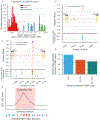Functional Genetic Variants Revealed by Massively Parallel Precise Genome Editing
- PMID: 30245013
- PMCID: PMC6563827
- DOI: 10.1016/j.cell.2018.08.057
Functional Genetic Variants Revealed by Massively Parallel Precise Genome Editing
Abstract
A major challenge in genetics is to identify genetic variants driving natural phenotypic variation. However, current methods of genetic mapping have limited resolution. To address this challenge, we developed a CRISPR-Cas9-based high-throughput genome editing approach that can introduce thousands of specific genetic variants in a single experiment. This enabled us to study the fitness consequences of 16,006 natural genetic variants in yeast. We identified 572 variants with significant fitness differences in glucose media; these are highly enriched in promoters, particularly in transcription factor binding sites, while only 19.2% affect amino acid sequences. Strikingly, nearby variants nearly always favor the same parent's alleles, suggesting that lineage-specific selection is often driven by multiple clustered variants. In sum, our genome editing approach reveals the genetic architecture of fitness variation at single-base resolution and could be adapted to measure the effects of genome-wide genetic variation in any screen for cell survival or cell-sortable markers.
Keywords: CRISPR; Cas9; QTL; evolution; fitness; genetic variation; genome editing; yeast.
Copyright © 2018 Elsevier Inc. All rights reserved.
Figures





Comment in
-
Putting genetic variants to a fitness test.Nat Rev Genet. 2018 Nov;19(11):667. doi: 10.1038/s41576-018-0056-4. Nat Rev Genet. 2018. PMID: 30279525 No abstract available.
References
-
- Bao Z, HamediRad M, Xue P, Xiao H, Tasan I, Chao R, Liang J, and Zhao H (2018). Genome-scale engineering of Saccharomyces cerevisiae with single-nucleotide precision. Nat. Biotechnol 36, 505–508. - PubMed
Publication types
MeSH terms
Grants and funding
LinkOut - more resources
Full Text Sources
Other Literature Sources
Molecular Biology Databases
Research Materials

